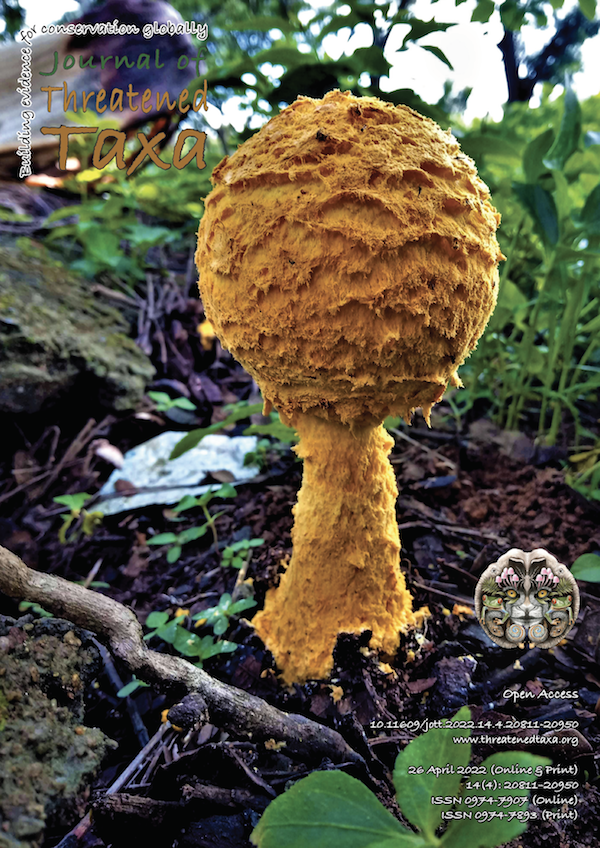Group size pattern and distribution of threatened Sambar Rusa unicolor (Artiodactyla: Cervidae) in Moyar River Valley, India
Main Article Content
Abstract
Sambars are usually observed as solitary or in small groups with fewer than six individuals. We discuss some insights on infrequent larger aggregations of Sambar based on our sighting records between January 2018 and January 2020 in the Moyar River Valley landscape of Tamil Nadu, southern India.
Article Details

This work is licensed under a Creative Commons Attribution 4.0 International License.
Authors own the copyright to the articles published in JoTT. This is indicated explicitly in each publication. The authors grant permission to the publisher Wildlife Information Liaison Development (WILD) Society to publish the article in the Journal of Threatened Taxa. The authors recognize WILD as the original publisher, and to sell hard copies of the Journal and article to any buyer. JoTT is registered under the Creative Commons Attribution 4.0 International License (CC BY), which allows authors to retain copyright ownership. Under this license the authors allow anyone to download, cite, use the data, modify, reprint, copy and distribute provided the authors and source of publication are credited through appropriate citations (e.g., Son et al. (2016). Bats (Mammalia: Chiroptera) of the southeastern Truong Son Mountains, Quang Ngai Province, Vietnam. Journal of Threatened Taxa 8(7): 8953–8969. https://doi.org/10.11609/jott.2785.8.7.8953-8969). Users of the data do not require specific permission from the authors or the publisher.
Funding data
-
Science and Engineering Research Board
Grant numbers EMR/2016/003963
References
Bhupathy, S., C. Ramesh & A. Bahuguna (2014). Feeding habits of Indian rock pythons in Keoladeo National Park, Bharatpur, India. The Herpetological Journal 234(1): 59–64.
Eisenberg, J.F. & M. Lockhart (1972). An ecological reconnaissance of Wilpattu National Park, Ceylon. Smithsonian Institute Press, U.S.A, 118 pp.
Jammal, A.K. & A.J.T. Johnsingh (2015). Sambar Rusa unicolor, pp. 223–241. In: Johnsingh A.J.T. & N. Manjrekar (Eds.). Mammals of South Asia, Vol. 2. University press, Hyderabad, India, 739 pp.
Jhala, Y.V., Q. Qureshi, & A.K. Nayak (eds.) (2020). Status of tigers, co-predators and prey in India, 2018. National Tiger Conservation Authority, Government of India, New Delhi, and Wildlife Institute of India, Dehradun, 160 pp.
Johnsingh, A.J.T. (1983). Large mammalian prey-predators in Bandipur. Journal of the Bombay Natural History Society 80: 1–57.
Karanth, K.U. & M.E. Sunquist (1992). Population structure, density and biomass of large herbivores in the tropical forests of Nagarahole, India. Journal of Tropical Ecology 8(1): 21–35.
Krishnan, M. (1972). An ecological survey of the larger mammals of peninsular India. Journal of the Bombay Natural History Society 67: 496–501.
Leslie Jr, D.M. (2011). Rusa unicolor (Artiodactyla: Cervidae). Mammalian Species 43(871): 1–30.
Menon, V. (2014). Indian Mammals: A Field Guide. Hachette India, 158 pp.
Prasanna, A.J.G. (1990). Ecology of the Sambar (Cervus unicolor) at Mudumalai Wildlife Sanctuary. M.Sc. Dissertation. Loyola College, University of Madras, 112 pp.
Ramachandran, K.K., P.V. Nair & P.S. Easa (1986). Ecology of larger mammals of Periyar Wildlife Sanctuary. Journal of the Bombay Natural History Society 83: 505–524.
Ramesh, T., K. Sankar, Q. Qureshi & R. Kalle (2012). Group size, sex and age composition of chital (Axis axis) and sambar (Rusa unicolor) in a deciduous habitat of Western Ghats. Mammalian Biology 77(1): 53–59.
Sankar, K. (1994). Ecology of three large sympatric herbivores (chital, sambar and nilgai) with special reference for reserve management in Sariska Tiger Reserve, Rajasthan, PhD Thesis. University of Rajasthan, Jaipur, 190 pp.
Sankar, K. & B. Acharya (2004). Sambar (Cervus unicolor Kerr, 1792), pp. 163–170. In: Sankar, K. & S.P. Goyal (eds.). Ungulates of India. ENVIS Bulletin, Wildlife and Protected Areas, Volume 7(1). Wildlife Institute of India, Dehradun, 448 pp.
Schaller, G.B. (1967). The Deer and the Tiger. The University of Chicago Press, Chicago, 370 pp.
Thirumurugan, V., N. Prabakaran, V.S. Nair & C. Ramesh (2021). Ecological importance of two large heritage trees in Moyar River valley, southern India. Journal of Threatened Taxa 13(1): 17587–17591. https://doi.org/10.11609/jott.6095.13.1.17587-17591
Timmins, R., K. Kawanishi, B. Giman, A. Lynam, B. Chan, R. Steinmetz, H.S. Baral & N.S. Kumar (2015). Rusa unicolor. The IUCN Red List of Threatened Species 2015: e.T41790A85628124. Accessed on 20th April 2022. https://doi.org/10.2305/IUCN.UK.2015-2.RLTS.T41790A22156247.en
Varman, K.S. & R. Sukumar (1993). Ecology of Sambar in Mudumalai Sanctuary, southern India, pp. 273–284. In: Ohtaishi, N. & H.I. Shen (eds.). Deer of China: Biology and Management. Elsevier Science Publishers, Amsterdam, The Netherlands, 432 pp.

